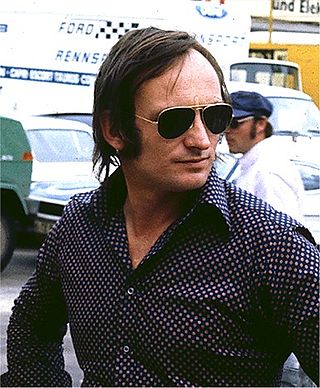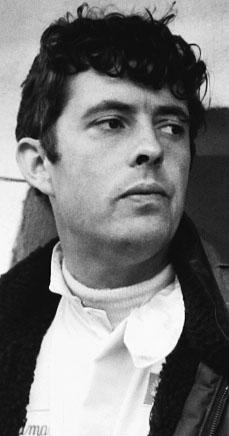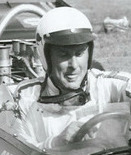
Christopher Arthur Amon was a New Zealand motor racing driver. He was active in Formula One racing in the 1960s and 1970s, and is widely regarded as one of the best F1 drivers never to win a championship Grand Prix. His reputation for bad luck was such that fellow driver Mario Andretti once joked that "if he became an undertaker, people would stop dying". Former Ferrari Technical Director Mauro Forghieri stated that Amon was "by far the best test driver I have ever worked with. He had all the qualities to be a World Champion but bad luck just wouldn't let him be".
Robert Brett Lunger is an American racecar driver.

Repco is an Australian automotive engineering/retailer company. Its name is an abbreviation of Replacement Parts Company and was for many years known for reconditioning engines and for specialized manufacturing, for which they gained a high reputation. It is now best known as a retailer of spare parts and motor accessories.

Brian Herman Thomas Redman, is a retired British racing driver.

Graham McRae was a racing driver from New Zealand. He achieved considerable success in Formula 5000 racing, winning the Tasman Series each year from 1971 to 1973, and also the 1972 L&M Continental 5000 Championship in the United States.

John Cannon was a sports car racer, who competed under the banner of Canada, though he was born in London, U.K. He raced in the USRRC series, the CanAm Series and the L&M Continental Series.
Tom Belsø was a motor racing driver, credited as the first Formula One driver from Denmark.

Vernon John Schuppan is a retired Australian motor racing driver. Schuppan drove in various categories, participating in Formula One, the Indianapolis 500 and most successfully in sports car racing.
Warwick Brown is a former racing driver from Australia.

Formula 5000 was an open wheel, single seater auto-racing formula that ran in different series in various regions around the world from 1968 to 1982. It was originally intended as a low-cost series aimed at open-wheel racing cars that no longer fit into any particular formula. The '5000' denomination comes from the maximum 5.0 litre engine capacity allowed in the cars, although many cars ran with smaller engines. Manufacturers included McLaren, Eagle, March, Lola, Lotus, Elfin, Matich and Chevron.

Oran Park Raceway was a motor racing circuit at Narellan south west of Sydney, New South Wales, Australia which was operational from February 1962 until its closure in January 2010. The track was designed and started by George Murray and Jack Allen. Since its closure in 2010 it has been developed into housing.
Graeme Lawrence is a race car driver from New Zealand. He started serious motor racing in the National 1.5 litre series winning the series decisively in 1968 ahead of David Oxton and Ken Smith. Lawrence then ran half a European F2 series in an uncompetitive semi works F2 McLaren, he found the racing harder than expected and was shaken, by his experience racing in Germany at the Hockenheim race in the rain, were Jim Clark was killed. McLaren allowed Lawrence to build up another F2 chassis in his works and was 2nd in the SR Gold Star series in the car, and first ST driver home in the Tasman races at Pukekohe and Levin.
The 1972 Australian Grand Prix was a motor race for cars complying with the Tasman Formula, which admitted both Formula 5000 and 2-litre racing cars. It was held at Sandown International Raceway, Victoria, Australia on 20 February 1972.
The Rothmans International Series was an Australian motor racing series which was staged annually from 1976 to 1979. Initially open to Australian Formula 1 cars, for the final year it was for ‘’Australian Formula 5000’’, ‘’World Formula 1’’ and ‘’Australian Formula Pacific’’ cars.

Johnnie Walker is a former Australian racing driver, born in Adelaide, South Australia. He first raced in the early 1960s at Mallala in his Holden FE road car. After competing in the Australian Formula 2 Championship he graduated to Formula 5000 in 1972, driving an Elfin MR5 and a Matich A50 before switching to the Lola marque in late 1973.
The 1975 Tasman Series,, was a motor racing competition open to Racing Cars complying with the Tasman Formula. Contested over eight rounds in New Zealand and Australia beginning on 5 January and ending on 23 February, it was the twelfth and final Tasman Series. The series was organised jointly by the Motorsport Association of New Zealand and the Confederation of Australian Motorsport and was promoted as the Peter Stuyvesant International Series for the 1975 Tasman Championship.

After the great success of the T332 in the 1974 Formula 5000 season, much was expected of the new high-tech Lola T400. Described by development driver Frank Gardner as "the most sophisticated Formula 5000 to be built so far", the T400 was a completely new design, strikingly different from its T300, T330 and T332 predecessors.

The Brabham BT43 was the only Formula 5000 racing car built by Motor Racing Developments (MRD). Initiated by Ron Tauranac, designed by Geoff Ferris, and built by a team including Nick Goozee (monocoque) and Bob Paton (construction), it was one of the last cars produced by MRD before MRD was closed by the then new Brabham owner Bernie Ecclestone. Based on the Formula Two Brabham BT40 the BT43 featured a modified monocoque that incorporated the triangular cross section pioneered by the Brabham BT42 Formula One car which was designed by Gordon Murray. This distinctive pyramid shape not only kept the aerodynamic "stagnation point" low but also neatly allowed the incorporation of a "crushable structure" as required by the 1973 regulations which specified that all fuel tanks were to be protected by deformable structures. Engine and gearbox were the then de facto F5000 standard combination of a Chevrolet 302 cubic inch engine in an unstressed mounting and a Hewland DG300 gearbox. The fitment of these into what was a relatively small Formula Two sized car presented some design challenges. Front suspension components were BT40 while rear suspension components were a combination of Formula One and BT40.
Keith Holland is a British former racing driver from England who competed in various classes of racing in the 1960s and 1970s. He is known for winning the 1969 Madrid Grand Prix in a Formula 5000 car in a field which contained several Formula One entries. He was also a regular competitor in the British Formula 5000 Championship finishing third in the title standings on two occasions.
Formula 5000 or F5000 is a historic single seater, open wheeler series that is currently run in New Zealand.










